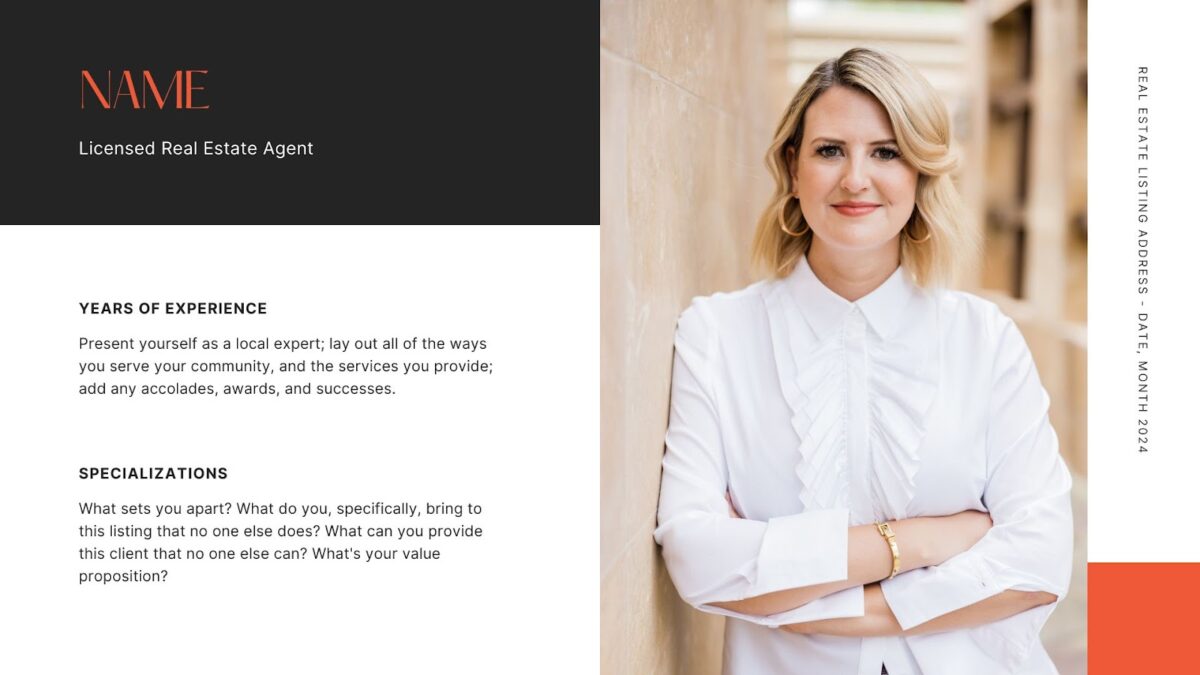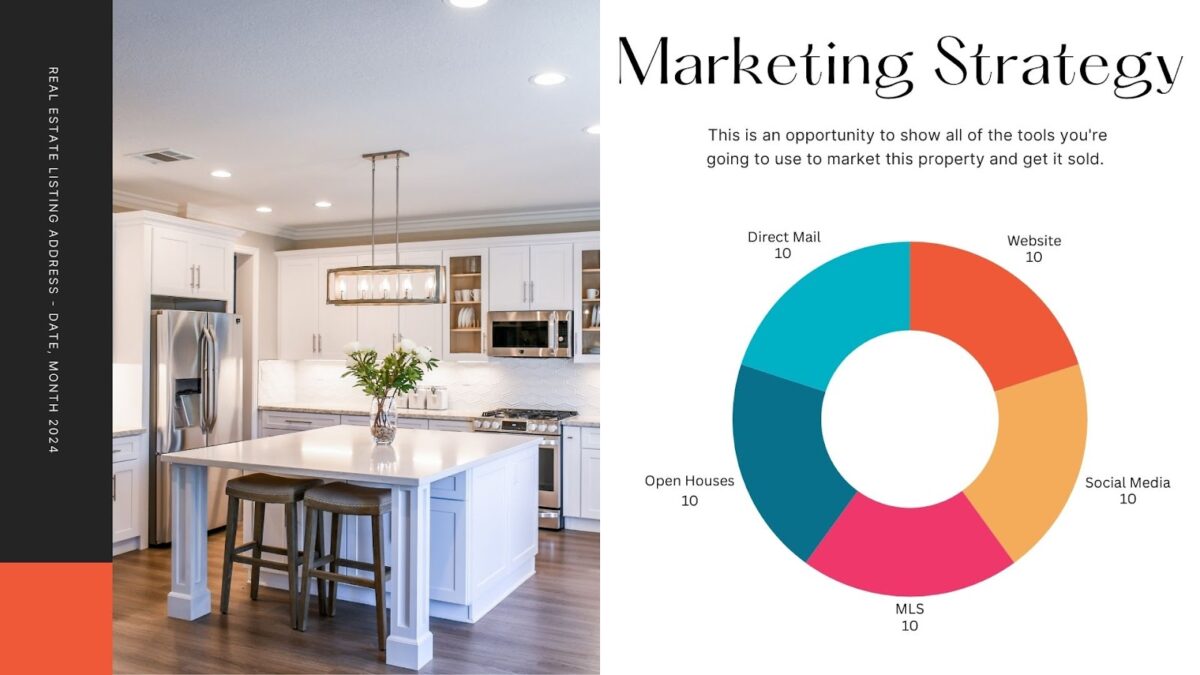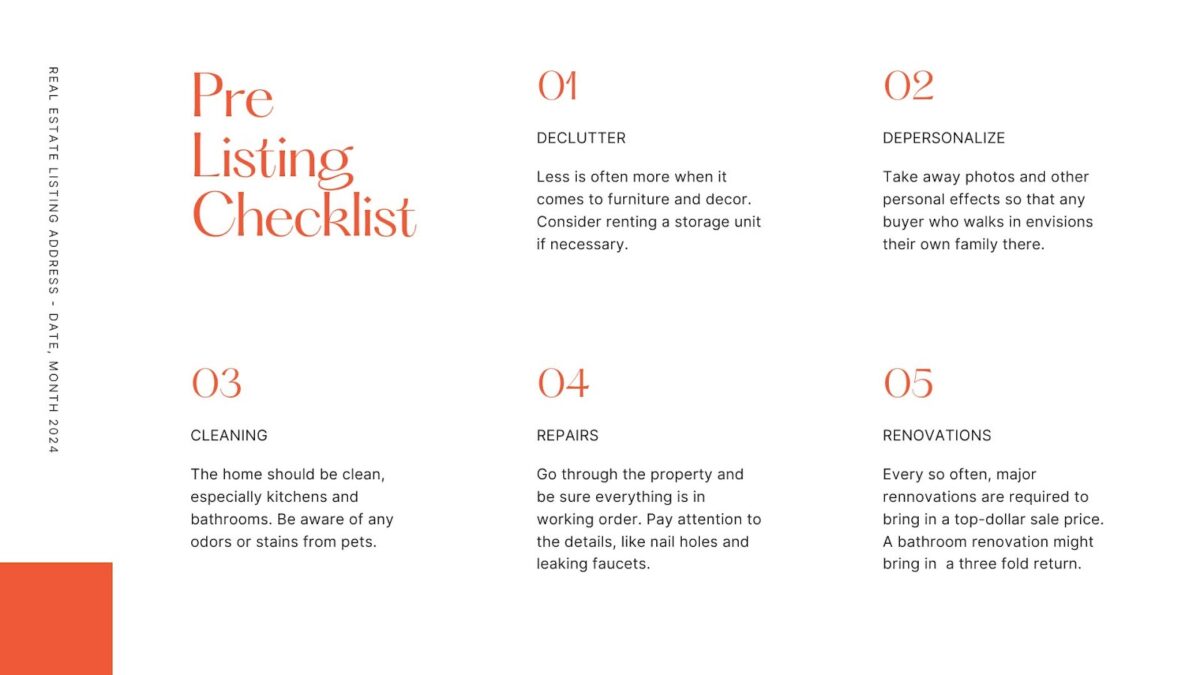
Brittany is a licensed real estate agent in Illinois with over 12 years of experience in the industry. She uses her sales, marketing, and business development background to educate agents and help them find sustainable ways to build their businesses. See full bio
Updated by Table of ContentsWe’ve all been there—getting a call from a potential seller eager to know how you can help them sell their property. But then you find yourself scrambling to put together or update your presentation so you can win the listing. Creating a presentation that showcases your skills, expertise, and ability to sell a home is a must for every agent. So, I’ve put together some tips and tricks to help you amp up your game and rock your listing presentation every time.

A real estate listing presentation is like the championship finals of selling homes; we want to claim victory. Normally, a potential seller shortlists a few real estate agents to meet with before selecting who will represent them in selling their property. This meeting is your opportunity to demonstrate your skills and expertise. You will have the chance to explain what makes you stand out and how you will assist the sellers in achieving their goals.
It’s important to understand the value of having a strong listing presentation. It’s not just about being prepared—there are so many benefits to having one ready to go. If you haven’t nailed yours down yet, here are some great reasons to consider putting one in place.
When it comes to your listing presentation, it’s important to feel confident and prepared. Everyone has a unique approach, so using tried-and-true methods customized to your personality will ensure you feel your best when presenting. Let’s break down the essential factors of each part of the listing presentation to give you a solid yet flexible structure to work with.
Let’s be real. The true first impression happened when you nailed down the listing appointment. Take the confidence from knowing they’ve shown interest in you and run with it. This is your opportunity to really connect and earn the seller’s trust. Share more about yourself and your background to show them how you can help sell their home.

Examples of What to Include:
💡Pro tip: If you are a high-volume agent, that’s great! It’s totally fine to talk about the busy business you’re running to demonstrate to potential sellers that you are in demand and fully capable. Just remember that some might be concerned that they won’t have your undivided attention if you’re juggling a lot. Use this chance to highlight how you effectively run your business, including any talented team members or agents who assist you in closing deals.
✋On the other hand: If you’re a new agent and don’t have a portfolio of sales to showcase, highlight your determination to put in the work and give your full attention to their home sale. You can also invite a more seasoned agent to join you to show that you have support and experience on your side. Or, if you’re on a team, leverage the expertise and accomplishments of the team.
Now that your client knows a little bit about you, give them a chance to share more about themselves, their home, and their goals. This is your opportunity to demonstrate genuine interest and care, showing that your focus goes beyond securing the listing. This may also allow you to discover valuable information that will enable you to customize your presentation as you go.

Examples of What to Include:
A realtor listing presentation is not just about showing the client what you can do to sell their home but also about building a relationship. Starting the presentation with some conversation that helps you get acquainted is a way to allow everyone to let their guard down and feel more comfortable.
Taking a tour of the home will then ease into pricing and strategy conversations. It’s important to allow the seller to guide you through their home before you get into these conversations so that you can get an idea of how the property stacks up to the competition and adjust as needed.

Examples of What to Do While Touring:
Now that you’ve had a chance to check out the home, it’s time to review your CMA with the seller. This is the part where you really get into the nitty-gritty of the numbers. Use all the info you gathered during the home tour and apply it to the comparables you share.
It’s your chance to show the seller how important it is to price their home appropriately and how that directly impacts market time. Since sellers often have a specific price in mind, this may involve some back-and-forth, so make sure you have the data to back up your pricing strategy.

Examples of What to Include:
When it comes to listing a property, it’s all about marketing. This is your chance to impress the sellers with your creative ideas to get their home sold. Besides the standard MLS listing, professional photography, video tours, and just listed mailers, show them what makes your selling strategy unique.
Talk to the sellers about the many different ways you can market their home for sale. This includes off-market options such as promoting their home as a pocket listing before going live on the public market. How about hosting fun-themed broker opens or open houses? Do you have a standout social media strategy? Share some examples, and remember to be transparent about the cost associated with your services.

Examples of What to Include:
In addition to showcasing your creativity with marketing, give the sellers some tips on how they can enhance their home’s appeal to potential buyers. Involving sellers in this process will also ensure they actively contribute to selling their homes. Encourage decluttering and suggest small yet impactful changes like a fresh coat of paint, which can help the home sell faster.

Examples of What to Include:
You’ve discussed your experience, built a solid rapport with the seller, learned more about the property, and discussed your winning strategy. Now is the time to drive home and explain why you’re the right agent for the job. Take this moment to highlight the exceptional support and guidance you’ll provide the seller throughout the transaction. This will give them a better understanding of your responsibilities and what they can expect from you.

Examples of What to Include:
Once you have reviewed and gathered all of the necessary information, it’s time for the final push. Wrap up the real estate listing presentation with a call to action, encouraging the seller to sign the listing agreement. Be prepared for possible objections, as some sellers may not want to sign anything right away. Give them a taste of your negotiating and persuasive skills that you use when working on a deal.

Examples of What to Ask:
💡Pro tip: During this last part of the listing presentation, you may experience seller objections like “The Zillow Zestimate is higher than your suggested list price” or “You’re charging more commission than another agent.” Learn how to tackle these objections in our article, “10 Real Estate Objections + How to Overcome Them.”
Although you may boast confidence and feel like you covered all your bases, the decision to sell is big, and some sellers may feel unsure for various reasons. If the seller you are meeting with is struggling to move forward, be prepared to tackle some objections they may throw your way. Here are just a few common examples you may encounter:
Although this is not part of the actual presentation, following up is a crucial step, regardless of the outcome of your listing presentation. The type of follow-up you send will depend on whether or not the seller signed the listing agreement with you.
Even if you didn’t secure the listing this time, you never know when the sellers might want to work with you directly or refer you to someone in the future. And if they did sign with you, now is the time to start wowing them and proving why you were the perfect choice.
You now have everything you need to truly impress potential sellers! Just remember to focus on the little details that will help you hone your skills and improve your presentation. Keep these extra prep tips in mind before meeting with clients.
First things first—you have to lock in the listing appointment. Once you have the date and time set, it’s time to gather as much info as possible from the seller. This will help you put together a CMA without even setting foot in the home. Once you have all the data you need for a list price estimate, add it to your listing presentation. Be sure to include all the steps in your selling strategy. Depending on how you like to present, you can prepare your listing presentation in a digital or print format. Also, get together any marketing materials and other samples you’d like to bring along.
A prelisting presentation isn’t always necessary, but if you decide to use it, it’s the information you’d give to the potential seller before the actual listing presentation. This might include details about you, your team, or your brokerage. It could also help you fully focus on building the relationship with the seller and your sales pitch on the day of your presentation.
You may have heard the phrase “list to last,” which means having a strong inventory of listings is essential for long-term success in the real estate industry. Listings play a crucial role in attracting potential buyers and help boost your marketing efforts. So, honing in on your listing presentation can significantly improve your chances of securing more listings and expanding your business.
While you’re sure to find plenty of listing presentation examples online, keep in mind that what makes it unique is you. What is your favorite aspect of your listing presentation?